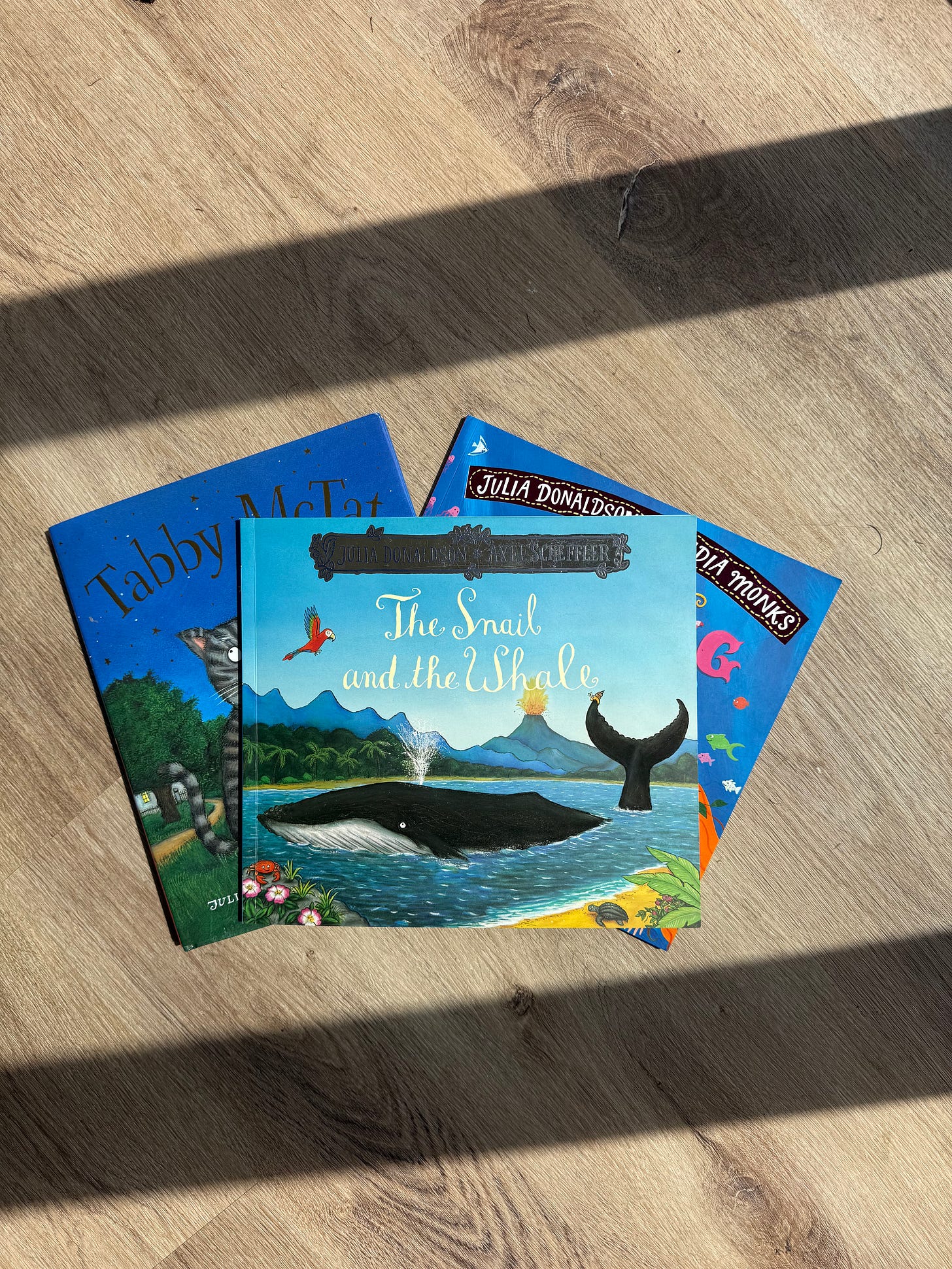The difference between good and bad children's books
Plus: a definite list of the 5 best Julia Donaldson stories
I have concluded recently there are two types of kids books. There are those that are actually written for children. They tend to be silly and, if they’re good, a little bit wicked. Then there are those that look like they are written for children but are really written for adults. They tend to be gentle and cautious and revolve around some perfectly reasonable moral message or other. They also tend to grossly underestimate the average child’s appreciation of plot, character development and – above all – silliness and wickedness.
Then there is a third group, in which only the most rarefied authors sit. These are books that please children and adults just as much as each other. Books that are as fun to read out loud as they are to listen to. This is where you find Roald Dahl, Jacqueline Wilson and the late, great Allan Ahlberg and his partner Janet.
Most of all, it’s where you find Julia Donaldson.
A colleague of mine wrote a profile of Julia Donaldson – the best-selling children's author in the UK, surpassing even J.K. Rowling in lifetime sales – a few years ago for the Guardian. This insight from it stuck out to me the most: Donaldson, who used to be a busker, constructs her picture books like songs.
Parents and children who (equally) love The Gruffalo, Room on a Broom, Zog and her other gazillion-selling classics will instantly understand what this means. It’s not just the musical cadence of Donaldson’s sentences, it’s the choruses and bridges the books contain: catchy, repeated refrains and often a section, midway through, where the rhythm structure of the lines change for a page or two to tee up a big finish.
Donaldson understands what children want – animals in mild peril, grotesque but ridiculous baddies who gets their comeuppance, authentic (i.e. not schmaltzy) notes of love and friendship – and she delivers it all with the precision and swagger you find in the greatest pop songs. Too many children’s books tiptoe along a once-upon-a-time, like a child’s attention is a pony you have to try not to startle. With Donaldson, you’re dropped straight into the action – a cat is abandoned, a rat is terrorising a highway, an earthworm is kidnapped – within a page or two.
Above all, reading her books out loud feels how I imagine it does to sing beautifully. “The books flatter you into thinking that you’re absolutely brilliant at reading,” Martin Pope, whose company produces animated films of Donaldson’s work, said in the Guardian piece. Often, when I’m reading one of her books to Olive, I’m silently hoping she doesn’t fall asleep or start grouching for something else because I’m enjoying myself too much. What a miracle. What a genius!
In the unlikely event any parents reading this are not acquainted with her work, here are the best five books Julia Donaldson in my humble opinion. I’d love to hear in the comments if people agree or disagree and which books of her they have a particular connection to.
The Gruffalo
Probably the most perfectly crafted – and certainly most famous – book in the Donaldson canon, The Gruffalo is about the triumph of brains over brawn as a small mouse outwits a series of would-be predators, including the titular knobbly-kneed monster, so he can enjoy his nuts in peace. As Anthony Burgess once said of The Old Man and the Sea: ““Every word tells, and there is not a word too many.”
Stick Man
It took me a few reads to warm to Stick Man, even though it’s the ‘one for Dads’. The story follows a stick who, through a series of unfortunate humiliations – being thrown for a dog, and so on – finds himself cast further and further from his stick wife and stick children. Clearly, this is an allegory for having a job, in which our connection to our family life is continuously violated by stresses outside the home. Towards the end, Donaldson flirts with Stick Man being burned alive – easily the most harrowing plot point in any of her books – but pulls it quite literally out the fire at the last minute via a cameo from Santa Claus.
The Highway Rat
“Give me your buns and your biscuits! Give me your chocolate éclairs! For I am the Rat of the highway, and the Rat Thief never shares!” One of Donaldson’s own favourite’s – she based it on ‘The Highwayman’ by Alfred Noyes, a poem she studied at school – the greedy rat who stalks an unidentified highway stealing food from other animals is one the great picture book antiheroes; just the right blend of menacing and pathetic and undone, in the end, by his own greed. I always thought the obsession with food in children’s books was a Victorian thing, but it is as delicious here as anywhere.
Tabby McTat
Another piece of music disguised as a picture book, Tabby McTat is about a singing moggy who gets separated from his owner, an old hippy busker called Fred. There’s something so emotionally rich about this story – with its themes of family, belonging and self-actualisation – which, incidentally, also includes an accidental same-sex couple.
“The cat gets taken in by Prunella and Pat,” Donaldson explained to The Independent, “it doesn’t really matter to me who he got taken in by because it had to rhyme with ‘cat’ actually. And as far as I thought about it, it was Pat as in Patrick. Axel [the illustrator] just thought, ‘Pat – Patricia.’ So he just drew Prunella and Patricia – so it’s two women living together.” Donaldson was soon happy to be getting letters of gratitude from same-sex female couples. Now that’s how you put a positive message in a kid’s story.
The Snail and the Whale
The greatest book of all time? From the vantage point of early fatherhood, I’m going to say, with apologies to Tolstoy et al, yes. A rock-dwelling gastropod – perhaps the least cute protagonist in kid’s book history, besides Donaldson’s own Super Worm – dreams of seeing the world, and does so by attaching itself to the tail of a great whale who sets off around the world.
The book is a masterpiece of prosodic storytelling, with tightly controlled meter, rich alliteration, and rhythmic phrasing that is somehow spellbinding but challenging at the same time. Reading it out loud makes me feel like Richard Burton getting his teeth into Under Milk Wood. Emotionally, it’s about having the curiosity and courage to go out and explore the world, an example set to me by my grandmother, which is why we named Olive after her, and why an extract from The Snail and the Whale is going to read out at my daughter’s naming ceremony later this month – the highest honour I can bestow upon it, ‘the greatest book of all time’ included.
Which is your favourite kids’ book?





The sheer number of times you’re forced to read children’s books is astonishing (as a new parent). I’m so grateful for JDs ability to make books that are super fun to read. I like to challenge myself to read an entire Donaldson book with a cadence that’s fun, sometimes I try to read the Gruffalo pretending to be Anthony from RHCP (try it, it’s fun). Another favorite author of mine is Robert Munsch, although a lot of his stories are pretty mediocre, Michael Martchenkos illustrations are inspirational. I might write a similar piece about RM soon! Thanks for this inspo.
My son's first exposure to Julia Donaldson was through Yoto, so he fell in love with the song they made for Monkey Puzzle. My mom, whose English is not so good, just adores Donaldson's books. I think the relatively simple rhyming and fun message ends up really resonating. She and my son love to play Gruffalo where one of them is the mouse and they reenact the whole book.
My least favorite books are not those that are fun for kids and boring or annoying for adults, but those "kids" books that are really just adults inserting adult messages — or even political messages — into kids books. I don't care, the kid doesn't care.